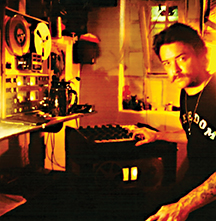The Lucifer Rising Suite: A Journey Out of Darkness
Bobby BeauSoleil
 San Francisco in the spring of 1967, it was, and the grand cultural experiment, that great hoax of freedom unfettered, was in full swing. Social forces swirled in dangerous eddies and crosscurrents, wreaking havoc and destruction and creative splendor by turns. Some of the people swept up in them became intoxicated with their belief that it was their role to usher in a bright new world. They were beautiful, and incredibly naïve.
San Francisco in the spring of 1967, it was, and the grand cultural experiment, that great hoax of freedom unfettered, was in full swing. Social forces swirled in dangerous eddies and crosscurrents, wreaking havoc and destruction and creative splendor by turns. Some of the people swept up in them became intoxicated with their belief that it was their role to usher in a bright new world. They were beautiful, and incredibly naïve.
Perfectly in keeping with the delirious spirit of those times in that city was the axiom of The Invisible Circus. This event was a neo-pagan free-for-all “happening” staged by The Diggers and their counter-culture cohorts in the inner sanctums of Glide Memorial Church. It would prove to be a pivotal point in my life.
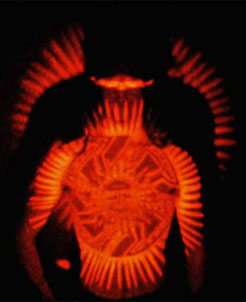 Opening ceremonies for the Invisible Circus festivities included a troupe of half-naked female dancers performing to experimental music by The Orkustra, a psychedelic experimental rock band I had founded the previous year. Something about my antics during the performance caught the interest of Kenneth Anger, who had joined the burgeoning crowd gathering at the church complex that evening. Later, as the band was packing the truck in preparation for departure, the filmmaker, who was as yet a stranger to me, approached and engaged me in conversation. Would I please play the part of Lucifer in his movie, he asked me. But I’m a musician, not an actor, I demurred. That’s okay, he countered, all you have to do is be yourself!
Opening ceremonies for the Invisible Circus festivities included a troupe of half-naked female dancers performing to experimental music by The Orkustra, a psychedelic experimental rock band I had founded the previous year. Something about my antics during the performance caught the interest of Kenneth Anger, who had joined the burgeoning crowd gathering at the church complex that evening. Later, as the band was packing the truck in preparation for departure, the filmmaker, who was as yet a stranger to me, approached and engaged me in conversation. Would I please play the part of Lucifer in his movie, he asked me. But I’m a musician, not an actor, I demurred. That’s okay, he countered, all you have to do is be yourself!
Under the circumstances, such a pronouncement seemed to be laced with double entendre and layered with meaning, and I didn’t know quite what to make of it. My interest had been primed nonetheless. Kenneth Anger’s reputation as a filmmaker had preceded him only slightly into my sphere of activity. The grapevine in my neck of the bay area underground carried rumors of Scorpio Rising, his previous film, which I had not yet seen. This vague knowledge combined with the animated fashion in which he spoke of his “love vision” for Lucifer Rising, his current work in progress, was enough to convince me that he was genuine.
Almost immediately my mind made a leap. I doubt that Mr. Anger was in any way prepared for the counter-proposal I made to him: that I would consider playing the role of the rebel angel in his film if he would consider allowing me to compose and perform the music for its soundtrack. We both struck a deal with the devil that night.
My counter-offer was hardly a momentary impulse. The notion of creating a movie soundtrack was a fantasy stemming from childhood and my innate attraction to instrumental music. Very early on it was the music in the movies I saw that interested me most, the Disney movies especially – the “Sorcerer’s Apprentice” from Fantasia remains one of my all-time favorite pieces of music. I realized early on that it was the haunting soundtracks that made the old horror movies seem so spooky and lent mystery and otherworldliness to early science fiction movies and television shows like The Outer Limits and The Twilight Zone. The birth of rock and roll (and yes, I was around when that happened) had a huge impact on me, and I was soon picking out songs I heard on the radio on a cast-off Sears and Roebucks guitar. Surf music became a big thing in my town not long afterward. And there it was, all my music loves rolled into one: instrumental rock music! I was off and running, playing guitar instrumentals by The Ventures, Dick Dale and the Deltones, and Duane Eddy. I thickened my finger calluses on songs like Booker T. and the MG’s “Green Onions” and Link Wray’s “Rumble.”
From this mish-mash of early influences there was, for me, a natural progression to the psychedelic music scene of the mid-1960s, where, seeded by mind-altering substances and fueled by electric instruments, long instrumental jams were the breeding ground of new forms of musical expression. My experiences with The Orkustra had provided me with a foundation for working with unusual instruments, amplifying and recording them, and employing them in the improvisational approach to composing music that seemed to come to me naturally. By the time I met Kenneth Anger, I was primed to leap on a potential opportunity to compose and record a psychedelic film soundtrack.
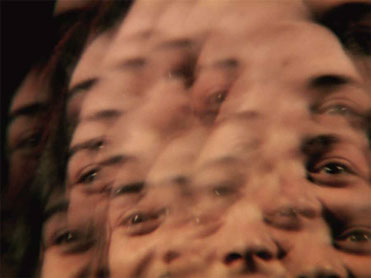 Shortly after we met, Kenneth treated me to a semi-private exhibition – with intermittent running commentary – of all of the films he had made up to that point in time. The homoerotic allusions in the films aside, I was genuinely impressed by his extraordinary approach to filmmaking. It seemed so revolutionary in comparison to any films I had previously seen in my young life. His keen eye and spontaneous editing style, richly saturated colors, and lyrical sensibility in the way some of the films were crafted, appealed to me. I venture that my relatively inexperienced eyes glimpsed evidence of undeniable genius in them as well. Moreover, I was naturally attracted to a style of filmmaking that did not utilize spoken dialogue. Any musical soundtrack attached to the visual components of the project would reign supreme and unchallenged in the sonic domain. I needed no further enticement, for my part, and my enthusiasm convinced Kenneth to agree to the collaboration.
Shortly after we met, Kenneth treated me to a semi-private exhibition – with intermittent running commentary – of all of the films he had made up to that point in time. The homoerotic allusions in the films aside, I was genuinely impressed by his extraordinary approach to filmmaking. It seemed so revolutionary in comparison to any films I had previously seen in my young life. His keen eye and spontaneous editing style, richly saturated colors, and lyrical sensibility in the way some of the films were crafted, appealed to me. I venture that my relatively inexperienced eyes glimpsed evidence of undeniable genius in them as well. Moreover, I was naturally attracted to a style of filmmaking that did not utilize spoken dialogue. Any musical soundtrack attached to the visual components of the project would reign supreme and unchallenged in the sonic domain. I needed no further enticement, for my part, and my enthusiasm convinced Kenneth to agree to the collaboration.
There is no way I could have known at the time I made this decision how the project, in its multiple evolving forms, would consume me. Nor could I have foreseen the way the archetypal themes in the story threads would define to a great extent the path of my spiritual experience and my development as an artist, leading me both to my undoing and, ultimately, to my salvation. By whatever mechanism – and I reckon that Kenneth’s influence in this, though initially significant, was relatively small – the spirit of the fallen angel had come to reside in me and be expressed through me in my life experiences, and especially in my art.
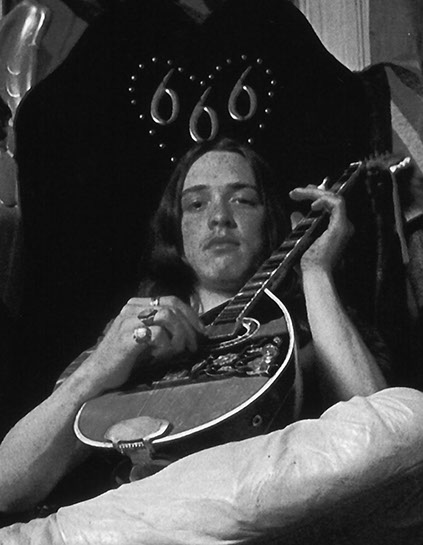 Back in ’67 it was all quite innocent and grandiose. For his part, Kenneth did nothing to discourage my reckless abandon as I adopted a persona commensurate with my dual roles. If he had any doubts that the beardless teenager I was then could actually deliver on a promise to produce a soundtrack for the film he did not reveal them outwardly. And, likewise, I ignored any niggling doubts I occasionally had that he might be playing me along on the soundtrack thing to secure my participation as personification of the mythical Lucifer for the film. There was no turning back for me. I was as one driven.
Back in ’67 it was all quite innocent and grandiose. For his part, Kenneth did nothing to discourage my reckless abandon as I adopted a persona commensurate with my dual roles. If he had any doubts that the beardless teenager I was then could actually deliver on a promise to produce a soundtrack for the film he did not reveal them outwardly. And, likewise, I ignored any niggling doubts I occasionally had that he might be playing me along on the soundtrack thing to secure my participation as personification of the mythical Lucifer for the film. There was no turning back for me. I was as one driven.
The other members of The Orkustra did not share my enthusiasm for the Lucifer Rising project, and this contributed to the disintegration of the band. While this development was disappointing and a serious setback, I would not allow it to be an insurmountable obstacle. Barely missing a beat, I began to seek out other free-spirited musicians to join me in a band that would eventually come to be called The Magick Powerhouse of OZ. The lineup consisted for the most part of free jazz players I literally found on street corners of the city. They were a motley, disparate bunch that rarely played in the same key. This was in keeping with the rebellious approach to composing I conceived for the film’s music: I wanted to break all the rules and preconceptions about what a movie soundtrack should be, yet that it be a perfect compliment to the film’s images. Although the band’s native style of playing music was predominantly improvisational, I established myself in the role of undisputed leader of the group to direct the modes, moods and melodic themes we improvised on. This I believed was necessary to give the free-form music some semblance of cohesive focus. The only standing rule was for the musicians in the band to cue on my gestures and musically fly along with me as best they could with their broken wings.
When Kenneth and I began working together in earnest it made sense that I take up residence in a section of the old Victorian mansion we called the Russian Embassy. Kenneth had rented the entire first floor of the rambling relic, and lived in a small apartment in the rear of the building. I moved into the front parlor, a large high-ceilinged room with could be doubled in size by opening tall pocket doors of dark wood leading from the parlor into an adjacent room. This gave me more than adequate space to rehearse the Magick Powerhouse, or for Kenneth to use when shooting film for the project.
The decisions relating to the music for the film were entirely my domain from the very start. Much to his credit, Kenneth remained aloof from that process, leaving me to my own devices with nary a discouraging word. This is remarkable indeed given the fact that he had not used experimental or avant-garde music as soundtrack source material for any of his films up to that point. If the primal shrieks and groans and pulsations that emanated from my apartment during Magick Powerhouse rehearsal sessions caused him any concern he did not let on. What neighbors and passersby may have thought is another matter altogether.
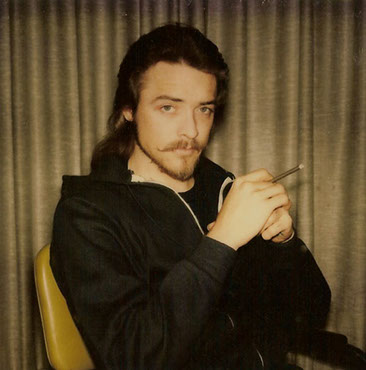 There is but one surviving recording of my initial work on the Lucifer Rising soundtrack. It was recorded in August of 1967 in a former Haight-Ashbury movie theater that had recently been renamed the Straight Theater. This site was chosen for recording sessions to take advantage of the old movie house’s excellent acoustics, and because the house sound engineer, Brent Dangerfield, was a friend of mine. On a couple of occasions he permitted us to set up our gear on the stage at night while the theater was not otherwise being used, in preparation for the band’s upcoming debut performance at the Straight Theater in October of that year. “Lucifer Rising I, 1967” is the sole artifact of music by The Magick Powerhouse of OZ, and is included in the Suite as an integral and bona fide part of the work as a whole.
There is but one surviving recording of my initial work on the Lucifer Rising soundtrack. It was recorded in August of 1967 in a former Haight-Ashbury movie theater that had recently been renamed the Straight Theater. This site was chosen for recording sessions to take advantage of the old movie house’s excellent acoustics, and because the house sound engineer, Brent Dangerfield, was a friend of mine. On a couple of occasions he permitted us to set up our gear on the stage at night while the theater was not otherwise being used, in preparation for the band’s upcoming debut performance at the Straight Theater in October of that year. “Lucifer Rising I, 1967” is the sole artifact of music by The Magick Powerhouse of OZ, and is included in the Suite as an integral and bona fide part of the work as a whole.
The story has been told of how our first collaborative attempt to make Lucifer Rising had come apart, coincident with the implosion of the San Francisco love movement that ceremoniously climaxed with the Death of Hippy funeral march down Haight Street in the fall of ’67. There were hard feelings and finger-pointings, too much of that, when the undertaking had for the most part collapsed under the weight of its own innocently bold premise.
Kenneth went to New York to lick his wounds. I returned to Los Angeles where I notoriously took a wrong turn, made a tragic blunder and wound up in prison for killing a man – yet another sixties casualty of sorts. I was down, devastated, in the darkest place imaginable, but I was not dead . . . dreams remained.
Occasionally a mutual friend sent me reports of Kenneth’s activities. He had moved to London, where he had found inspiration for a re-envisioned Lucifer Rising, making a fresh start on the project with financial support from Anita Pallenberg. It was widely reported that Jimmy Page of Led Zeppelin had been tapped to create the soundtrack. With location shoots in Egypt underway it was evident that Kenneth had recovered and was working on his underground epic in earnest.
When I read later in a magazine article that Kenneth and Jimmy Page had parted ways, and that Jimmy would not be producing the Lucifer Rising soundtrack after all, I contacted Kenneth, who had returned from England and was living in New York at the time, to offer him a new proposition. I was operating on some imperative that I can’t explain – the whole idea was frankly ridiculous. My overtures came out of a kind of blind faith that only someone with nothing left to lose can call upon.
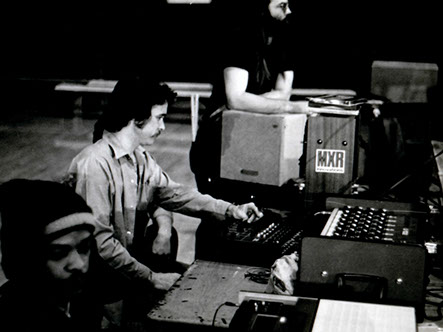 From a cellblock in Tracy’s “gladiator school” of a prison I wrote a few letters to Kenneth outlining my proposal that he once again entrust the soundtrack for the Lucifer Rising film project to me. Certainly he must have been skeptical, though he never said so in as many words. Even my fellow convicts expressed doubt that the California prison system would allow me the opportunity to do what I proposed. Still, the whole idea must have tickled Kenneth’s imagination, for he agreed. At the very least it would be fodder for the kinds of stories he liked to tell.
From a cellblock in Tracy’s “gladiator school” of a prison I wrote a few letters to Kenneth outlining my proposal that he once again entrust the soundtrack for the Lucifer Rising film project to me. Certainly he must have been skeptical, though he never said so in as many words. Even my fellow convicts expressed doubt that the California prison system would allow me the opportunity to do what I proposed. Still, the whole idea must have tickled Kenneth’s imagination, for he agreed. At the very least it would be fodder for the kinds of stories he liked to tell.
There were many daunting obstacles but none, it turned out that would be insurmountable. Soon I had the sponsorship of an elderly teacher at the prison, the blessing of the warden, a few grand from Kenneth for equipment and some instant coffee, and a handful of jailhouse musicians willing to back me up and help me to realize my musical vision. I was on my way – a man on a mission. And in only a few years I would make good on my promise to deliver a finished 45-minute soundtrack for the film.
The opening melody of the 1967 version of the score, performed then on my beloved bouzouki, made a reprise in the final version of the soundtrack I recorded in prison a decade later, only the second time around the lead melodic theme would be performed on an electronically processed trumpet. Little else carried over from the earlier rendition; certainly there would not be much of what might be called jazz elements in the recordings I subsequently made with the ever-changing prison band I called The Freedom Orchestra.
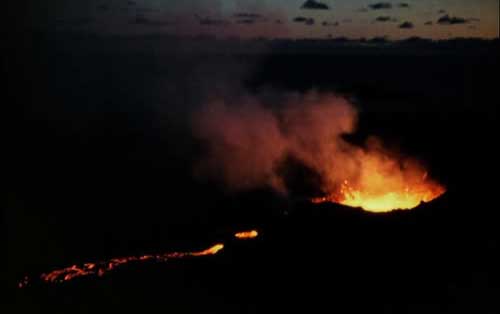 Most of the musicians I found in prison were rock and electric blues players. This suited me fine. Life experiences in the intervening years had changed me in profound ways. The petals had fallen away from the flower child I once was, and what remained was, well, the fruit from the bloom. I had by that time experienced and witnessed – and yes, wrought – great tragedy and awful horrors, and suffered their unpredicted consequences. My soul was torn and bleeding but the heart remained beating in strangely syncopated rhythms, imbuing a fresh furiousness in the energies that would inform the resurrection of the Lucifer Rising soundtrack project in the latter half of the 1970s. Darker moods and a harder edge would be called for this time around.
Most of the musicians I found in prison were rock and electric blues players. This suited me fine. Life experiences in the intervening years had changed me in profound ways. The petals had fallen away from the flower child I once was, and what remained was, well, the fruit from the bloom. I had by that time experienced and witnessed – and yes, wrought – great tragedy and awful horrors, and suffered their unpredicted consequences. My soul was torn and bleeding but the heart remained beating in strangely syncopated rhythms, imbuing a fresh furiousness in the energies that would inform the resurrection of the Lucifer Rising soundtrack project in the latter half of the 1970s. Darker moods and a harder edge would be called for this time around.
Necessity is the mother of invention – and that old adage certainly rings true in this case. Once the small advance had been spent on a basic multi-track recording setup, very little funding remained for buying instruments and accessories, or to do much to make up for the shortcomings of the ones we had. In order to broaden the palette of sounds I could draw from I took to building guitars and keyboards and electronic processing devices in the prison hobby shop, with some sporadic help from other members of my band. Over time I became adept at developing electronic circuits and variations of circuits I found in hobbyist magazines and newsletters that let me warp and bend sound in a variety of ways. When combining these circuits experimentally I occasionally stumbled on synthesis configurations, or “patches” that inspired new tangents in the direction of the music compositions. Some of those tangents led to compositional elements that I recorded solo in the privacy of my prison cell. Others became voicings in the ensemble mix with instrumentation selected from The Freedom Orchestra lineup and recorded in the prison band room or when we performed a live concert in the gymnasium.
Truth be told, most of the musicians who worked with me on the Lucifer Rising soundtrack project, if left too their own inclinations, would have preferred to play covers of tunes by The Allman Brothers, Santana, and the Charlie Daniels Band. To their credit, and to my immense gratitude, they allowed me to mold and shape their talents to create compositions with a high-flown sound that would resonate with the apocryphal Lucifer’s lofty disposition and mercurial tendencies.
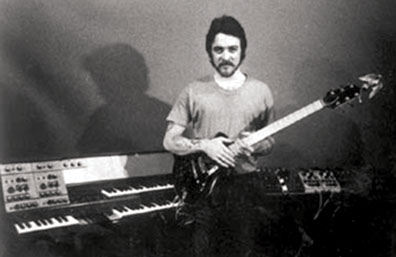 As a bandleader I was something of a tyrant at times. I expected a lot of the Freedom Orchestra members: dedication, good musicianship, a willingness to accept direction in a leap of faith, all for the privilege of being a part of something extraordinary – and that alone, as I could not offer much in the way of material compensation to the musicians who participated. There were arguments occasionally but the band rose to the challenges and thrived – despite the grim realities pervading our environment.
As a bandleader I was something of a tyrant at times. I expected a lot of the Freedom Orchestra members: dedication, good musicianship, a willingness to accept direction in a leap of faith, all for the privilege of being a part of something extraordinary – and that alone, as I could not offer much in the way of material compensation to the musicians who participated. There were arguments occasionally but the band rose to the challenges and thrived – despite the grim realities pervading our environment.
All during the making of the recordings we were beleaguered by the nightmare of ongoing prison gang wars, rioting, and the institution-wide lockdowns that would result. Somehow we managed through our dedication to the music to transcend the environment – a band of fallen angels reaching out of the darkness to touch the light of our higher natures.
Throughout my work on the soundtrack project in the second go-round my lines of communication with Kenneth were tenuous at best. I received no direction from him. Nor would I have welcomed any. At the start, when I viewed a slash print of the film-in-progress, I saw imagery comprising symbolism; metaphor and gesture in an invocation to the timeless archetypal forces at work in the transformative process that resides at the core of the film’s premise. It did not have a story to speak of, so I made it my job to tell Lucifer’s story through the emotive language of music. I knew instinctively that in order to do this I would have to embody the story, interpretively, in a very personal way. My circumstances and experiences provided the foundation. For inspiration I drew on the troubles and tribulations I had known in preceding years, my failings and their consequences, the turmoil and conflict raging in the prison, and in my own heart – all of this was to be converted into fuel to stoke the engines of desire. The longing for liberation, reconciliation and love informed the work to its conclusion.
During my preliminary discussions with Kenneth, he had said that he needed 45-minutes of music for the film. Piece of cake, I assured him, figuring on being able to fulfill that requirement within six months. Almost four years later I stuffed a tape of the final version of the soundtrack into a box and had it shipped to New York.
Not for want of devotion to the project did it take me so much longer than anticipated to complete it. Conditions and events conspired to complicate things. Use of the band room was limited to only a few hours a week – time that had to be divided between rehearsing the band and recording sessions. Paroles, transfers and trips to the hole for rule violations robbed me of musicians at the most inopportune junctures, requiring that I stop work to search out suitable replacements to fill gaps in the lineup.
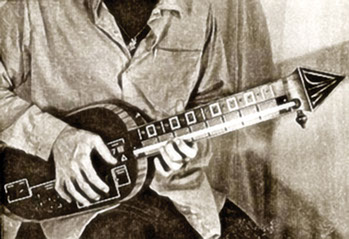 When it was not possible to rehearse or record the band, I composed new music themes, designed and built instruments, performed maintenance on the recording equipment, and gradually taught myself how to be a better sound engineer and recordist. Prison lockdowns became opportunities to mix and edit the recordings without interruption. More than all of this, though, the project took longer to complete than expected because the process of the music’s emergence into the world had taken a life of its own. I the artist – merely the instrument of its realization – was at its mercy. With the completion of each recorded section or movement the creative inspiration for the next would imperatively unfurl ahead of me until, at last, having filled many reels of tape with recordings, I understood that my work was done.
When it was not possible to rehearse or record the band, I composed new music themes, designed and built instruments, performed maintenance on the recording equipment, and gradually taught myself how to be a better sound engineer and recordist. Prison lockdowns became opportunities to mix and edit the recordings without interruption. More than all of this, though, the project took longer to complete than expected because the process of the music’s emergence into the world had taken a life of its own. I the artist – merely the instrument of its realization – was at its mercy. With the completion of each recorded section or movement the creative inspiration for the next would imperatively unfurl ahead of me until, at last, having filled many reels of tape with recordings, I understood that my work was done.
Arguably the greatest challenge of all came during the final editing stage when I had to decide which portions of several hours of multi-layered recordings would actually be included in the soundtrack for Kenneth’s film. Every part seemed important, and it was painful to choose which of my musical children would survive in the end product. In many cases I allowed sound quality to be the determining factor in my editing decisions. Some of the most musically interesting compositions and performances were left by the wayside because the delicate sensibilities of my golden ears determined that recording quality was marred by, for example, an excessive level of tape hiss.
It got worse. The film Kenneth Anger debuted in 1980 was a Lucifer Rising about half the 45-minute length he had projected the film would be. While this was his creative decision to make as the filmmaker, those who have been exposed to the music solely in conjunction with the film have heard only a severely truncated version of the soundtrack I had turned over to him – and this only a portion of the work as a whole.
Now, for the first time, all of the music composed for the soundtrack project has been compiled into a single public release. The Lucifer Rising Suite begins with the 1967 version of the soundtrack and continues through a logical sequence of the recordings made in the years spanning 1976-79. With respect to the latter, the original master tapes were mined for music that had not been heard by anyone in nearly three decades. The newly unearthed recordings were then restored, cleaned up and combined with those previously released to make the anthology as complete as possible.
From the outset it was my intention to create a soundtrack that would be a perfect compliment to Kenneth Anger’s film but strong enough on its own that it did not need to be propped up by a film to be fully appreciated as a work of art on its own merits. If this goal has been reached, the listener should experience the music presented here as a unified work, complete unto itself.
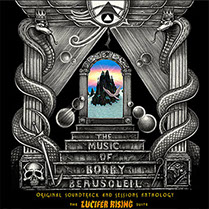 The compositions that comprise the Suite are sequenced in an order that tells a story, after a fashion. It is a story that may be impossible to tell in a strictly literary manner, one that – like a mirror’s reflection into another – is both personal and allegorical.
The compositions that comprise the Suite are sequenced in an order that tells a story, after a fashion. It is a story that may be impossible to tell in a strictly literary manner, one that – like a mirror’s reflection into another – is both personal and allegorical.
The myth of the fallen angel that is known in western culture has its origins in art. We are first introduced to Lucifer in a poem, the lament of Isaiah (14:12-14:14):
How art though fallen from heaven, O Lucifer, son of the morning! How art thou cut down to the ground . . .
From these scant few tantalizingly ambiguous lines in the Old Testament artists and poets, up through the centuries have extrapolated the rich, elaborate mythology of the Fallen One.
The Italian poet Alighieri Dante (1265-1321) gave us his Inferno – and a Lucifer who, as Lord over all the levels of Hell, personally oversees the agonizing sufferings of the uncountable human souls who for their sins must endure their miseries for all eternity. In his epic poem Paradise Lost, English poet John Milton (1608-74) tells the indelible story of the prideful Lucifer who leads a hopeless revolt against the tyranny in Heaven – a conflict that arises out of a dispute having to do with the status of humans. For his failed rebellion and his refusal to obey the Heavenly decree Lucifer is sentenced to perdition and cast down to earth in disgrace and defeat, there cursed to walk among the worldly creatures he despises.
So powerful are these stories that many people living today believe them, these fanciful myths, to be bona fide biblical scripture. Their value as instructive metaphor has been clouded over by this persistent belief. Instead, for many, monotheism has become dualism that divides the psyche against itself with notions of the existence of opposing gods of good and evil. It behooves us to remember that these stories are not literal truths but extant inventions very remotely derived from Isaiah’s lament – the original meaning of which we can only imagine.
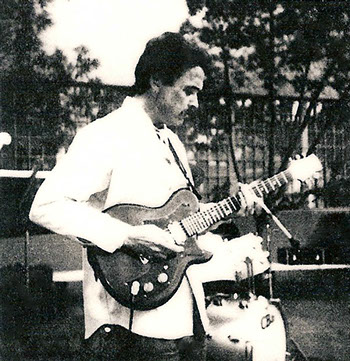 My interpretation for Lucifer Rising (which may or may not coincide with Kenneth Anger’s concept) continues the artistic tradition while expressing a desire to extend the story told in Paradise Lost. The essential premise is that Milton did not give his epic a very satisfying ending – or at least left it open for continuation in a sequel. For some of us, there is a distinct lack of moral sensibility in a conclusion that consigns the protagonist to perpetual disgrace and despair, to be characterized as the source of all evil in the world, and condemned to know only the relative darkness of isolation from the Beloved for all eternity. A merciful God of Love would not leave his favorite archangel so stranded without a path to redemption and liberation from self-imposed bondage and exile.
My interpretation for Lucifer Rising (which may or may not coincide with Kenneth Anger’s concept) continues the artistic tradition while expressing a desire to extend the story told in Paradise Lost. The essential premise is that Milton did not give his epic a very satisfying ending – or at least left it open for continuation in a sequel. For some of us, there is a distinct lack of moral sensibility in a conclusion that consigns the protagonist to perpetual disgrace and despair, to be characterized as the source of all evil in the world, and condemned to know only the relative darkness of isolation from the Beloved for all eternity. A merciful God of Love would not leave his favorite archangel so stranded without a path to redemption and liberation from self-imposed bondage and exile.
According to the myth, Lucifer’s downfall was his prideful assertion that human beings, mere creatures, were unworthy of being elevated to immortality and unfit to share the abode of Heaven with the angels. So great was his love for the Divine Presence that he rebelled rather than accept compliantly that beings he considered to be vastly inferior should be allowed to come between angels and the Beloved.
Lucifer Rising posits that as he shares the material world with humans, Lucifer gradually comes to recognize elements of humanity within himself. Through the lens of shared experience he also comes to see seraphic qualities expressed in humans, revealing an inherent capacity to emerge out of creature hood into realization of the divine light within. Through empathy, then, as humanity is redeemed to him, there too is the pathway to his own redemption.
The irony is not lost on Lucifer, who, on the buoyancy of an invigorated sense of humor, rises resplendent in the radiance for which he was named.
When I was originally cast to play Lucifer in ’67, my role was described to me as a portrayal of the disobedient angel representing the spirit of love rising to herald the dawn of a new age. When I composed and recorded the soundtrack for a re-conceptualized Lucifer Rising a decade later I drew on my own life experiences to tell the story in music evocative of the mythical Lucifer awakening in his pit of despair, rekindling his torch, and rising like a phoenix from the ashes of his own unmaking to begin his long journey from the dark recesses of the underworld–shedding his pride along the way in his uncompromising desire to regain the Beloved. In a strange, unexpected, but very real way, what Kenneth requested of me when we first met–that I portray the apocryphal Lucifer by being myself – is ultimately what came to be.
Ain’t life peculiar.
© 2014 Bobby BeauSoleil and BHDesigns. All Rights Reserved. | Images are copyrighted to their respective owners. Go to our Privacy Policy.

